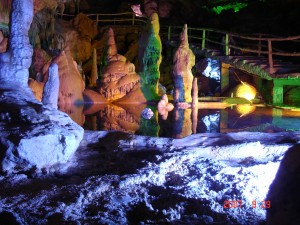Slow Monsoon Seasons Led to End of Chinese Dynasties
Like ice cores or tree rings, stalagmites (those are the ones that grow up from the cave floor) can record ancient history
/https://tf-cmsv2-smithsonianmag-media.s3.amazonaws.com/filer/20110520104008zhang1kids.jpg)
Like ice cores or tree rings, stalagmites (those are the ones that grow up from the cave floor) can record ancient history—weather patterns, temperature, etc.—in their growth rings. A group of scientists in China, (publishing in last week’s Science,) found a stalagmite in Wanxiang Cave in central China (see photos below) that provided a record of the seasonal Asian Monsoon between 190 and 2003 A.D. These rains, which last for weeks during the summer, allow farmers in this region grow rice and other food. When the scientists matched up that record with Chinese history, they found some interesting correlations: the Chinese kingdom was strong during periods when the monsoon seasons were wet, and three dynasties (Tang, Yuan and Ming) ended during dry eras. The scientists write: "Whereas other factors would certainly have affected these chapters of Chinese cultural history, our correlations suggest that climate played a key role."
The idea that when food is plentiful people are happy, prosperous and content with their government but less so when food is scarce is not new (Jared Diamond’s Collapse has several good examples). However, it is interesting to see how this played into some of China’s more momentous bits of history.
And then the scientists have another important point: over much of the time of their study, the monsoon’s strength was determined by the sun’s energy and northern European glaciers. But in 1960, the most important factor became air pollution.

(Photo Credits: Science/AAAS)
/https://tf-cmsv2-smithsonianmag-media.s3.amazonaws.com/accounts/headshot/Sarah-Zielinski-240.jpg)
/https://tf-cmsv2-smithsonianmag-media.s3.amazonaws.com/accounts/headshot/Sarah-Zielinski-240.jpg)